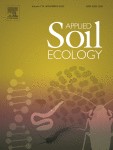Ver ítem
- xmlui.general.dspace_homeCentros e Institutos de InvestigaciónCIRN. Centro de Investigaciones de Recursos NaturalesInstituto de Clima y AguaArtículos científicosxmlui.ArtifactBrowser.ItemViewer.trail
- Inicio
- Centros e Institutos de Investigación
- CIRN. Centro de Investigaciones de Recursos Naturales
- Instituto de Clima y Agua
- Artículos científicos
- Ver ítem
Land cover, plant residue and soil microbes as drivers of soil functioning in temperate agricultural lands. A microcosm study
Resumen
Feedbacks between plants and soil microbes are critical for ecosystem regulation and restoration. Soil microbial diversity is largely dependent on plant diversity, yet these relationships have received little attention at the landscape scale. In agricultural landscapes, the presence of different plant cover types (landscape elements) can modulate these feedbacks by adding spatial heterogeneity through changes in the amount and composition of plant
[ver mas...]
Feedbacks between plants and soil microbes are critical for ecosystem regulation and restoration. Soil microbial diversity is largely dependent on plant diversity, yet these relationships have received little attention at the landscape scale. In agricultural landscapes, the presence of different plant cover types (landscape elements) can modulate these feedbacks by adding spatial heterogeneity through changes in the amount and composition of plant residues. Furthermore, it can also influence the soil biota. Therefore, the more diverse the landscape elements of farmlands, the higher the increase of their heterogeneity. We investigated the microbial catabolic profiles and respiration rates of soils from different plant cover types through the manipulation of plant residues and microbial communities. In individual microcosms, we incubated sterilized soils sampled from five different cover types of a temperate agricultural landscape: Soybean Monocropping, two crop rotations (Rotation and Intensified Rotation) and two uncropped margins: Herbaceous and Woody spontaneous vegetation. We amended them with each of two plant residues: wheat stubble (Wheat) and a mix of spontaneous vegetation (Mix). Soils were also inoculated with each of two soil microbial communities: Soybean Monocropping and Woody margins.
We predict that soils treated with the Mix residue and the Woody margins community will show higher catabolic diversity and respiration than those treated with Wheat stubble and Soybean Monocropping community. In turn, we predict that soils from Woody margins, with higher carbon content, will respire more and amplify the effects of plant residue and microbial community. The microbial catabolic profile changed with plant residue and microbial community whereas the microbial respiration changed with cover type. After 30 days of incubation, soils inoculated with Woody margin community sustained higher diversity than those inoculated with Soybean
Monocropping community. Conversely, Wheat stubble increased microbial diversity with respect to the Mix, particularly in soils from Woody margins while Mix residue increased the microbial diversity of soils from Soybean Monocropping. Finally, microbial respiration of soils from Woody margins showed the greatest respiration and Soybean Monocropping the lowest, in correlation with their carbon contents. Despite the complex interactions between soil carbon contents and plant residue composition, our results suggest that internal transfers of soil and plant residue between the different landscape elements might contribute to increasing the resilience of agricultural landscapes.
[Cerrar]

Autor
D' Acunto, Luciana;
Iglesias, María Agustina;
Poggio, Santiago Luis;
Semmartin, María Gisela;
Fuente
Applied Soil Ecology 193 : 105133. (January 2024)
Fecha
2024-01-01
Editorial
Elsevier
ISSN
0929-1393
Formato
pdf
Tipo de documento
artículo
Palabras Claves
Derechos de acceso
Abierto
 Excepto donde se diga explicitamente, este item se publica bajo la siguiente descripción: Creative Commons Attribution-NonCommercial-ShareAlike 2.5 Unported (CC BY-NC-SA 2.5)
Excepto donde se diga explicitamente, este item se publica bajo la siguiente descripción: Creative Commons Attribution-NonCommercial-ShareAlike 2.5 Unported (CC BY-NC-SA 2.5)


